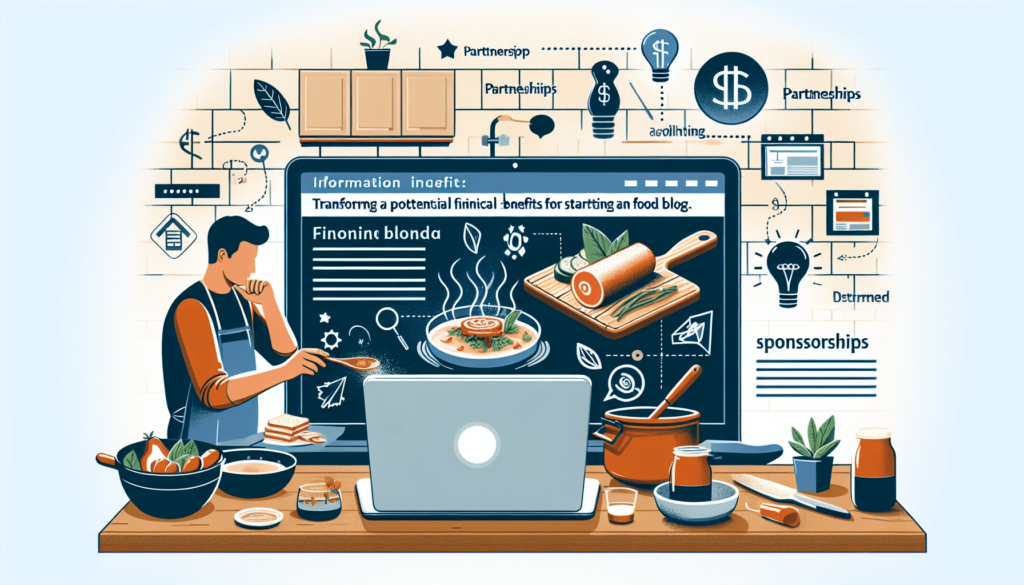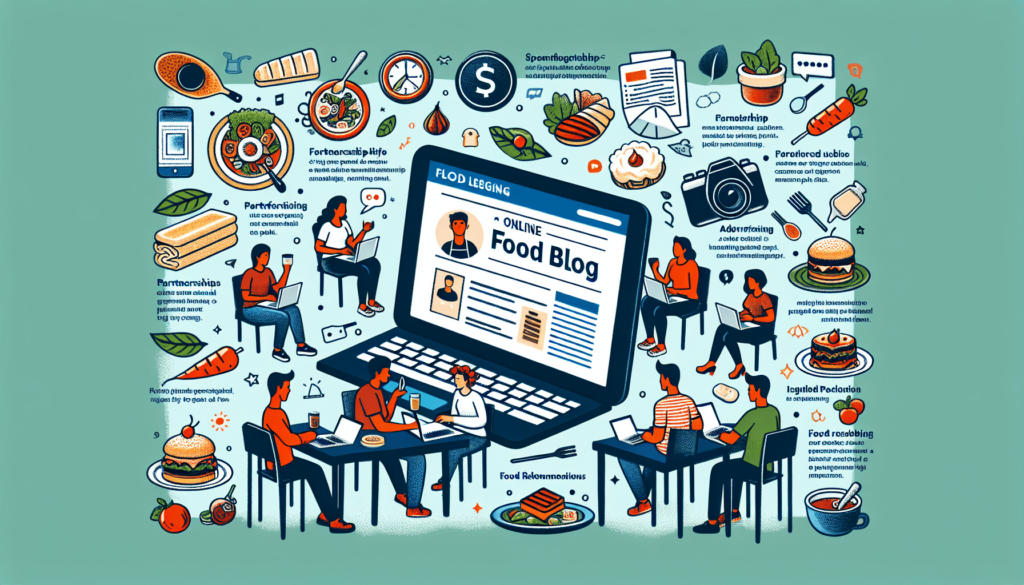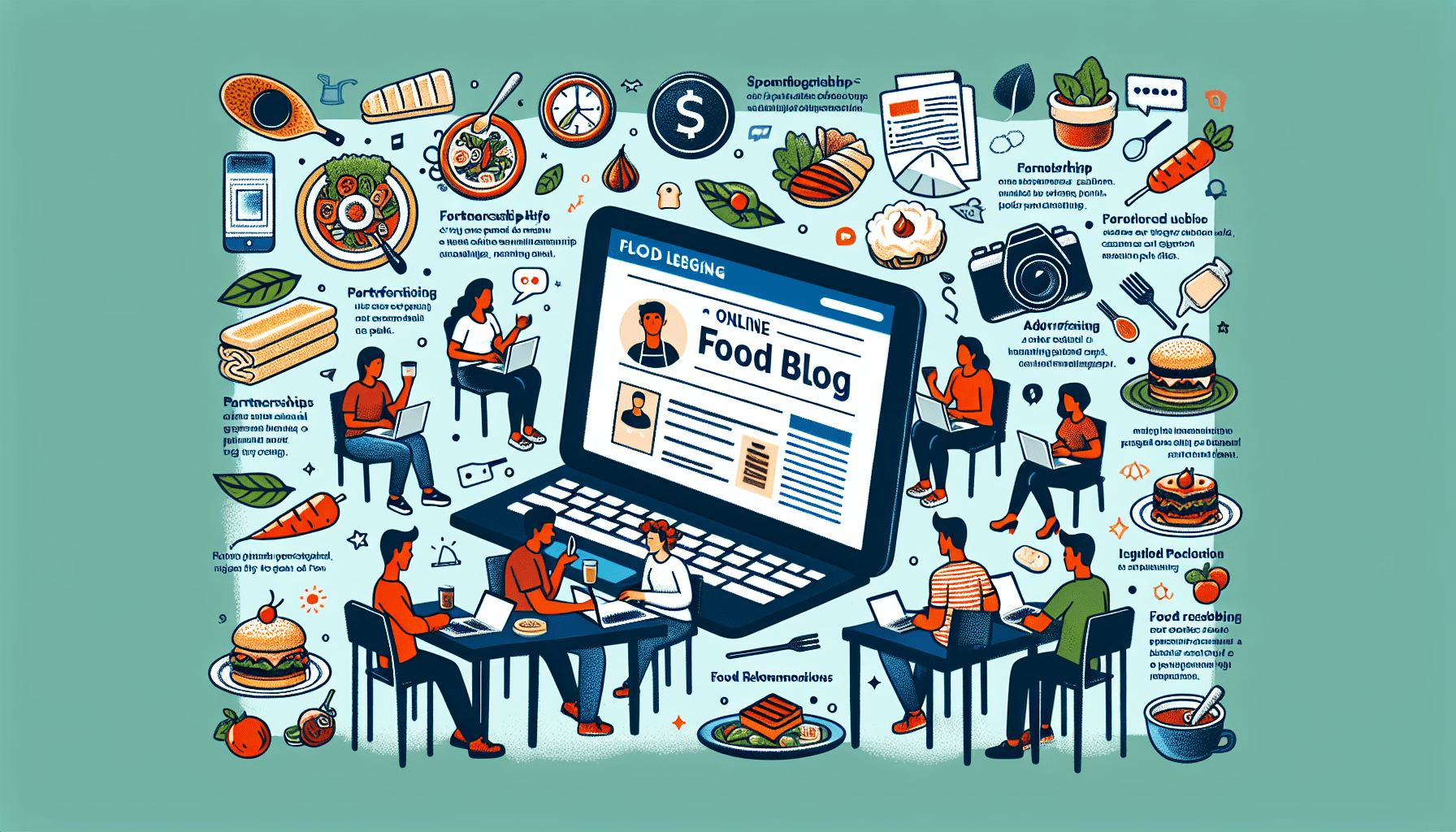Looking to turn your passion for food and writing into a profitable venture? Look no further than an online food blog! With endless possibilities and the ability to connect with a global audience, starting an online food blog can be a lucrative way to achieve financial gain. Wondering what strategies work best for making money with an online food blog? In this article, we’ll explore the innovative techniques that can help you capitalize on your culinary expertise and build a successful online food blog empire. So grab a cup of coffee, and let’s dive right in!

Unlock Earning Power: My $7 Mega Link Secret Revealed!
Choosing a Profitable Niche
When starting an online food blog, choosing a profitable niche is crucial. It’s important to identify popular food trends that are currently in demand. By staying informed about the latest food trends, we can ensure that we are providing content that people are interested in. This could mean focusing on plant-based recipes, gluten-free options, or even regional cuisines that are gaining popularity.
In addition to identifying popular food trends, it’s also important to find a unique angle or specialty within that niche. This could involve focusing on a specific type of cuisine or exploring a particular dietary restriction. By finding our own unique niche, we can set our blog apart from the competition and attract a dedicated audience.
Lastly, researching audience demand is essential. We need to understand who our target audience is and what they are looking for in a food blog. Through market research, surveys, and engaging with our readers, we can gain valuable insights into what our audience wants. By catering to their needs and preferences, we can build a loyal following and increase our chances of success.
Building a Strong Online Presence
Once we have identified our niche, it’s time to build a strong online presence for our food blog. One of the first steps in doing so is creating a visually appealing and user-friendly website. Our website should reflect the aesthetic of our brand and make it easy for visitors to navigate and find the information they’re looking for. Including high-quality food photography and an intuitive layout can greatly enhance the user experience.
In addition to a website, utilizing social media platforms effectively can help us reach a wider audience. We should establish a presence on platforms such as Instagram, Facebook, and Pinterest, where food content is especially popular. By consistently posting engaging content and interacting with our followers, we can attract more traffic to our blog and increase our visibility.
Networking with other food bloggers and influencers is another effective way to build our online presence. By collaborating with others in our niche, we can tap into their audience and gain exposure. This can be done through guest posting, cross-promotion, or even hosting joint events or giveaways.
Life-Changing: How a Simple Link Brought Me Financial Freedom!
Producing High-Quality Content
The heart of any successful food blog is high-quality content. To keep our readers engaged and coming back for more, we need to focus on delivering unique and engaging recipes. This could involve putting our own spin on classic dishes, experimenting with new ingredients, or even creating innovative fusion recipes. By continuously developing new and exciting recipes, we can capture the interest of our audience and set ourselves apart from the competition.
Alongside recipes, visually captivating food photography is essential. People eat with their eyes, and a beautifully presented dish can entice readers to try our recipes. Investing in a good camera, learning about lighting techniques, and practicing food styling can help us create stunning visuals that showcase our culinary creations.
In addition to recipes and food photography, writing compelling and informative blog posts is another important aspect of producing high-quality content. Sharing personal anecdotes, providing cooking tips, or delving into the history and cultural significance of certain dishes can make our blog more engaging and educational. By offering valuable content, we can establish ourselves as a reliable source of information in the food blogging community.
Monetizing the Blog
Once we have built a strong online presence and produced high-quality content, it’s time to monetize our food blog. There are several avenues we can explore to generate revenue.
One common monetization method is advertising through sponsored posts and display ads. Brands may pay us to create content featuring their products, or we can display ads on our blog and earn money based on clicks or impressions. It’s important to carefully select advertising opportunities that align with our brand and resonate with our audience.
Joining affiliate marketing programs is another effective way to monetize our blog. By promoting products or services that we genuinely believe in, we can earn a commission for every sale that is made through our affiliate links. Researching and partnering with reputable affiliate programs can provide us with a steady stream of passive income.
Offering sponsored product reviews or giveaways can also be a lucrative monetization strategy. Brands may send us products to review or offer giveaways to our audience, and in return, we receive compensation or the products themselves. This not only provides a source of income but also allows us to create valuable content for our readers and introduce them to new and exciting products.

Daily Payday From Your Couch? Try now for the cost of a cup of coffee!
Developing a Loyal Audience
Building a loyal audience is integral to the success of our food blog. Engaging with readers through comments and social media is a great way to foster relationships and create a sense of community. Responding to comments, answering questions, and showing appreciation for our readers’ support can help cultivate a loyal following.
Building an email newsletter subscriber list is another effective way to engage with our audience. By offering exclusive content, such as behind-the-scenes sneak peeks or bonus recipes, we can incentivize readers to sign up for our newsletter. Regularly sending out newsletters can keep our audience informed about new blog posts, upcoming events, and any special promotions or discounts we may be offering.
It’s also important to listen to our audience and take their feedback and suggestions into account. By regularly seeking input and implementing changes based on their preferences, we can show our readers that we value their opinions. This can lead to increased loyalty and a stronger connection with our audience.
Collaborating with Brands and Businesses
Collaborating with brands and businesses can not only help us monetize our blog but also increase our visibility and credibility. Forming partnerships for sponsored content is a common way to collaborate. This could involve developing recipes featuring specific products, creating video content, or reviewing restaurants or cooking equipment. These collaborations not only provide financial compensation but also introduce our blog to a wider audience through brand promotions.
Guest posting on other relevant websites is another effective way to collaborate and expand our reach. By contributing guest posts to established food blogs or publications, we can tap into their readership and gain exposure. This can drive traffic back to our own blog and potentially attract new readers who are interested in our content.
Participating in food events and festivals is yet another way to collaborate and expand our network. By attending these events, we have the opportunity to meet other food bloggers, chefs, and industry professionals. Collaborating on events, creating content together, and sharing each other’s work can help us reach new audiences and establish valuable connections within the industry.
Shocking! This one link can pay you time and time again!
Creating and Selling Digital Products
Creating and selling digital products can be a great way to diversify our income streams and provide additional value to our audience. One popular option is designing and selling eCookbooks. By compiling our best recipes, photography, and cooking tips into an eBook format, we can offer a comprehensive resource to our readers. Promoting our eCookbooks through our blog, social media channels, and email newsletters can help drive sales.
Offering online cooking classes or tutorials is another digital product that we can create and sell. This allows us to share our knowledge and expertise with our audience in a more interactive format. Whether it’s a live cooking class or pre-recorded video tutorials, offering online courses can attract new readers and provide them with valuable culinary skills.
Creating personalized meal plans or recipe bundles is another way to monetize our expertise. By curating meal plans that cater to specific dietary needs or providing themed recipe bundles, we can offer convenience and inspiration to our audience. This can be done through a subscription model or as a one-time purchase, depending on our preferences.
Implementing Effective SEO Strategies
Implementing effective Search Engine Optimization (SEO) strategies is crucial for ensuring our blog ranks well in search engine results. Optimizing blog posts for relevant keywords and search queries can help us attract organic traffic from search engines. Performing keyword research and strategically including keywords in our blog post titles, headings, and throughout the content can improve our visibility and increase the likelihood of our content being discovered by new readers.
Building high-quality backlinks is another aspect of SEO that can improve our blog’s search engine rankings. By reaching out to other relevant websites, food bloggers, and influencers in our niche, we can collaborate on guest posts, link exchanges, or even feature each other’s content. These backlinks signal to search engines that our blog is trusted and reputable, improving our overall rankings.
Improving website loading speed and ensuring mobile responsiveness is also crucial for SEO. Search engines prioritize websites that provide a good user experience, and slow-loading pages or websites that are not optimized for mobile devices may be penalized in search rankings. Optimizing images, using caching plugins, and ensuring that our website is responsive on different screen sizes can help improve our SEO performance.
Unlock Earning Power: My $7 Mega Link Secret Revealed!
Maximizing Revenue through Email Marketing
Email marketing is a powerful tool for maximizing revenue from our food blog. By segmenting our email list, we can target specific promotions to different groups of subscribers. This allows us to provide more personalized offers and increase the likelihood of conversions. For example, we could send exclusive discounts on baking supplies to subscribers who have shown an interest in baking or send a special promotion on cooking classes to those who have previously expressed interest in our educational content.
Offering exclusive discounts and deals to our email subscribers is another effective way to generate revenue. By providing our loyal subscribers with special offers, we incentivize them to make purchases and potentially refer our blog to others. These exclusive deals can create a sense of exclusivity and make our subscribers feel valued.
Promoting affiliate products or services through our email newsletters is yet another way to monetize our blog. By recommending products that we genuinely use and love, we can earn a commission for every purchase made through our affiliate links. Offering personalized recommendations and highlighting the benefits of these products can increase our chances of conversions.
Diversifying Income Streams
Finally, diversifying our income streams is essential to ensure long-term financial success with our food blog. Creating and selling merchandise or branded products can be a great way to generate additional income. This could include branded aprons, cookware, or even specialized ingredients. Building a strong brand that resonates with our audience can increase sales and create an additional revenue stream.
Offering sponsored content on social media platforms is another avenue for diversifying our income. Brands may pay us to promote their products or services on platforms like Instagram or Facebook. By creating engaging and authentic sponsored content, we can earn money while continuing to provide valuable content to our audience.
Exploring opportunities for public speaking or cooking demonstrations can also diversify our income streams. By sharing our knowledge and expertise at food events, conferences, or even local cooking classes, we can earn money through speaking fees or ticket sales. These opportunities not only provide additional income but also help establish us as industry experts and further promote our blog.
In conclusion, building a profitable online food blog requires careful consideration of various factors. Choosing a profitable niche, building a strong online presence, producing high-quality content, monetizing the blog, developing a loyal audience, collaborating with brands and businesses, creating and selling digital products, implementing effective SEO strategies, maximizing revenue through email marketing, and diversifying income streams are all key components to achieving financial gain through an online food blog. By following these strategies and continuously evolving our approach, we can create a successful and sustainable food blogging business.
Life-Changing: How a Simple Link Brought Me Financial Freedom!

